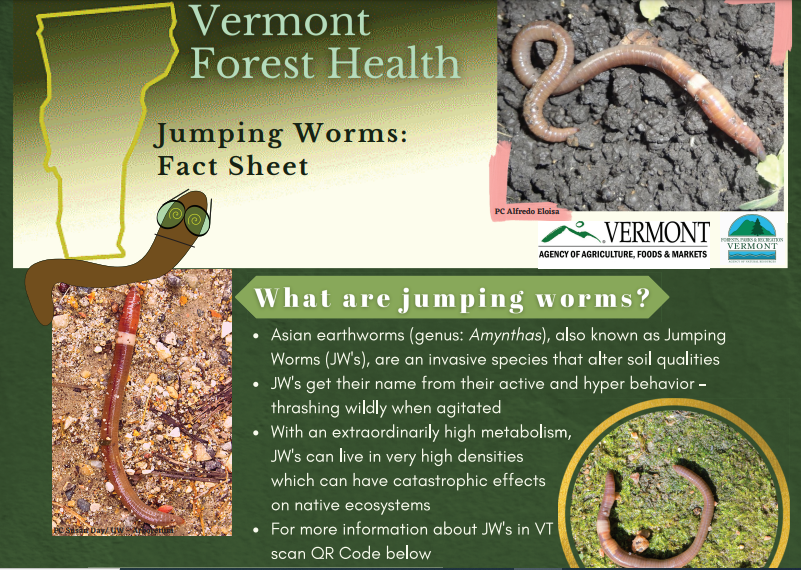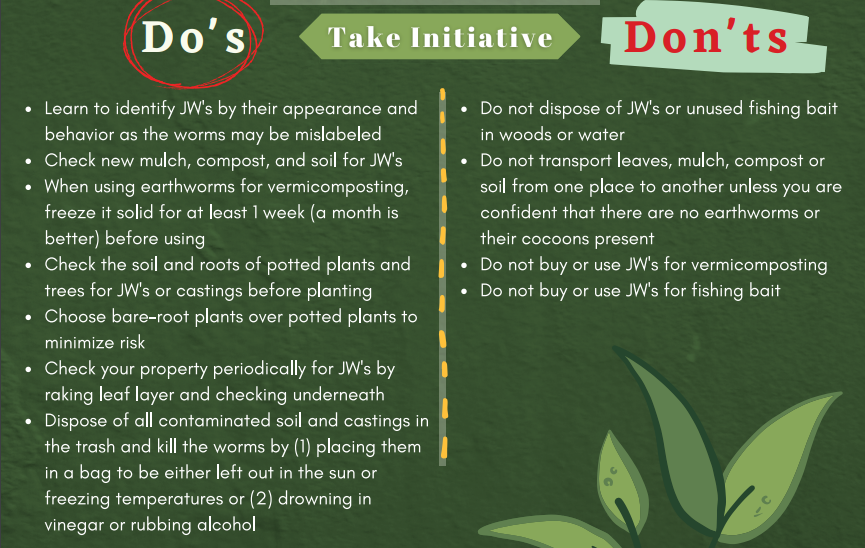Jumping Worms

Image of worms and text:
Vermont Forest Health
Jumping Worms: Fact Sheet
What are Jumping Worms?
- Asian earthworms (genus: amynthas) also known as Jumping Worms (JW's) are an invasive species that alter soil qualities
- JW's get their name from their active and hyper behavior - thrashing wildly when agitated
- With an extraordinarily high metabolism, JW's can live in very high densities which can have catastrophic effects on native ecosystems
- For more information about JW's in VT scan QR Code below

Image of worms/diagram and text:
What's the damage?
- Jumping Worms pose a threat to:
- forest health by altering soil structure and density
- biodiversity in affected areas
- JW's change soil structure by consuming the upper organic layer of soil, which leaches nutrients and erodes the ground making the soil inhospitable for some plants and animals
- The crumbly soil created by jumping worms makes it hard for many plants (including garden plants) to grow and threatens even the most well-tended lawns.
Image/diagram:
diagram showing the difference between European nightcrawler (raised clitellum. further from head) and Jumping worm (smooth clitellum, closer to head)

Image of worm/diagram and text:
Jumping Worm Description
- Life Cycle:
- Most have an annual cycle - hatching in the spring from poppy-seed-sized cocoons and maturing after 70-90 days later
- Once mature, the worms can produce new cocoons without a mate in the late fall after which the adults diem but the cocoons over-winter to start the next generation
- Behavior: The worms thrash wildly when agitated and often jump or flip over. Sometimes they cast off the end of their tail
- Castings: Their casting (feces) appear like coarse coffee grounds that create a loose layer between leaf litter and mineral soil beneath
- Look-alikes: Unlike nightcrawlers, which have a raised pin-red collar (clitellum) more central along the body, Jumping worm adults have a smooth milky-white collar close to the head end.
Diagram text:
- Jumping Worm: Amynthas agrestis
- Size: 70-160mm x 5-8mm
- 63-100 segments
- Reddish brown iridescent worm that will thrash and jump when disturbed
- each segment has a ring of setae
- Large distinct mouth
- Clitellum: milky, smooth, flush, annular

Image text:
Take Initiative
| Do's | Don'ts |
|---|---|
| Learn to identify JW's by their appearance and behavior as the worms may be mislabeled | Do not dispose of JW's or unused fishing bait in woods or water |
| Check new mulch, compost, and soil for JW's | Do not transport leaves, mulch, compost or soil from one place to another unless you are confident that there are no earthworms or their cocoons present |
| When using earthworms for vermicomposting, freeze it solid for at least 1 week (a month is better) before using | Do not buy or use JW's for vermicomposting |
| Check the soil and roots of potted plants and trees for JW's or castings before planting | Do not buy or use JW's for fishing bait |
| Choose bare-root plants over potted plants to minimize risk | |
| Check your property periodically for JW's by raking leaf layer and checking underneath | |
| Dispose of all contaminated soil and castings in the trash and kill the worms by (1) placing them in a bag to be either left out in the sun or freezing temperatures or (2) drowning in vinegar or rubbing alcohol |

Image of worms, text and a QR code:
Report it!
vtinvasives.org